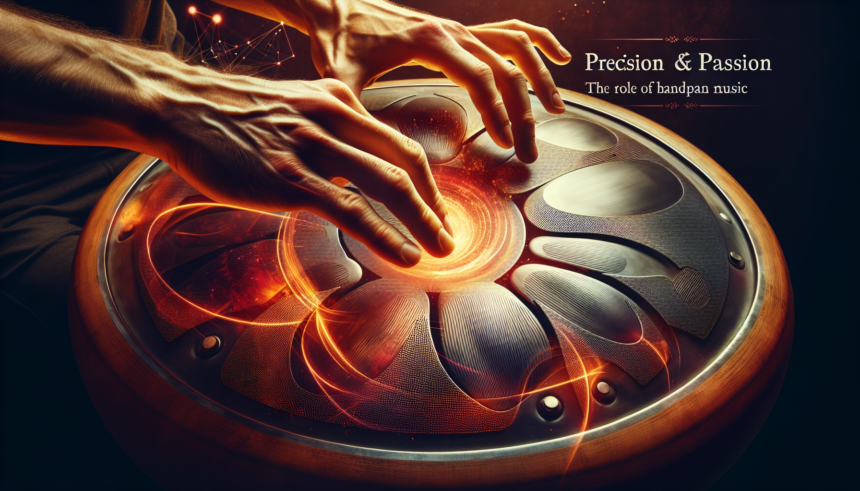<!DOCTYPE html>
<html lang="en">
<head>
<meta charset="UTF-8">
<meta name="viewport" content="width=device-width, initial-scale=1.0">
<title>Precision and Passion: The Role of Flams in Handpan Music</title>
</head>
<body>
<article>
<header>
<h1>Precision and Passion: The Role of Flams in Handpan Music</h1>
</header>
<section>
<p>Handpan music has emerged as a beautifully resonant and rhythmic soundscape that captivates audiences
worldwide. This unique instrument, often resembling a steel UFO, carries with it a mystique that's both
enigmatic and enchanting. Its appeal lies in its versatility as much as its tonal beauty, and at the crux
of this lies the technique of flams.</p>
<p>So, what exactly are flams? In the world of percussion and especially handpan music, a flam is a
rudiment or a fundamental drumming technique used to add texture and dynamism to music. It involves a
simultaneous striking of two tones in quick succession that creates a fuller sound than a single hit.
Flams add depth, drama, and complexity, serving as a key aspect of performance for those who wield
the handpan with finesse.</p>
<p>The essence of music is often a blend of technical proficiency and emotional resonance. Flams in
handpan music embody this duality. To execute a perfect flam, a player must exercise precision, allowing
the note to resonate fully while creating a layered texture. However, beyond the technical, it is the
musician's passion that animates the flam, transforming it from a stylistic device into an expressive
force that transcends the theoretical.</p>
<h2>The Mechanics of Playing Flams</h2>
<p>Understanding the mechanics of flams is imperative for any aspiring handpan musician. A typical flam
begins with a grace note—played lightly and just milliseconds before the primary note. The grace note
is called "the pre-stroke" and is quieter than the main stroke, which is referred to as "the primary hit."
This subtle, yet distinct, delay results in a nuanced, rich timbre.</p>
<p>A common misconception is that the speed of the pre-stroke should be consistent across all flam
executions. However, variations in the speed, force, and angle of hand or finger can lead to a broad
spectrum of sounds and expressions. Indeed, in handpan music, versatility in flams is not just encouraged
but celebrated.</p>
<h2>Flams as a Tool for Emotional Expression</h2>
<p>Beyond the technicality, the emotive power of flams cannot be understated. As a musician skillfully
manipulates the handpan, flams serve as a conduit for conveying a wide array of emotional states—from
calm serenity to invigorating energy. This emotion-driven evolution of sound is integral to the appeal
of handpan music, often inducing a meditative state in listeners.</p>
<p>The passionate delivery of flams can transport an audience, evoking past memories or inspiring future
dreams. It's a form of storytelling that transcends words, carried solely on the back of nuanced sound
and rhythmic precision. The timbral complexity brought forth through flams enables musicians to explore
the depths of human emotion, offering a reflective space both for themselves and their audiences.</p>
<h2>Technical Mastery and Innovative Techniques</h2>
<p>Mastering the flam technique is essential for any handpan player looking to deepen their musical
expression. Achieving proficiency involves rigorous practice to develop the necessary precision and
timing. A skilled player understands the role of their hands, forearms, and even their whole body in
producing the complex interplay of sounds that flam techniques enable.</p>
<p>Innovative musicians continue to expand the boundaries of what is possible with flams by incorporating
them into intricate rhythms or blending with other elements such as harmonics and ghost notes. Such
innovations often lead to new, unique signatures, establishing a player's identity in their musical
creations. The fusion of flams into other musical styles—ranging from classical to jazz or world music—
creates fresh pathways for exploration and outreach in handpan music.</p>
<h2>Teaching and Learning Flam Techniques</h2>
<p>Instructional resources and tutorials have grown exponentially in recent years, largely thanks to
technological advances and platforms like YouTube. Budding musicians often begin by watching videos
or attending workshops that break down the flam technique through visual and auditory demonstrations.</p>
<p>One-on-one sessions with seasoned players can also be immensely beneficial, offering personalized
feedback geared towards the unique strengths or challenges faced by the student. Education in this
realm can ignite a deeper passion as players build a repertoire filled with varied flam patterns.</p>
<h2>Conclusion</h2>
<p>Handpan music, bolstered by the distinctive use of flams, is an ever-evolving art form that epitomizes
the balance of precision and passion. Through flams, musicians can create deeply layered textures and
deliver captivating performances that speak directly to the human spirit. As more musicians delve into
this domain, it's evident that the delicate dance between technique and emotion continues to elevate
handpan music into a fully immersive experience.</p>
<p>Flams, in their nuanced yet significant presence, offer a window into the intertwining paths of
technical mastery and raw emotion, each essential for crafting the vibrant tapestries that have come
to characterize handpan music today.</p>
</section>
<section>
<h2>FAQs</h2>
<ul>
<li>
<strong>What is a flam in handpan music?</strong>
<p>A flam is a percussion technique involving a quick succession of two tones, with a grace note
played just before the primary hit, adding depth and texture to music.</p>
</li>
<li>
<strong>How does practicing flams benefit a handpan player?</strong>
<p>Practicing flams improves a player's precision, timing, and breadth of musical expression.
It allows musicians to convey emotions more effectively and expand their repertoire.</p>
</li>
<li>
<strong>Are flams unique to handpan music?</strong>
<p>No, flams are a common drumming rudiment found in various percussion music genres. However,
their application in handpan music is notable for the unique emotional depth they bring.</p>
</li>
<li>
<strong>Can flams be incorporated into other musical styles?</strong>
<p>Yes, flams can be integrated into many styles, including jazz, classical, and world music,
enriching those genres' rhythmic and tonal expressions.</p>
</li>
<li>
<strong>Where can I learn flam techniques for handpan music?</strong>
<p>Flam techniques can be learned through online resources, music workshops, one-on-one sessions
with experienced players, and various instructional videos available on platforms like YouTube.</p>
</li>
</ul>
</section>
</article>
</body>
</html>Precision and Passion: The Role of Flams in Handpan Music

Leave a comment




